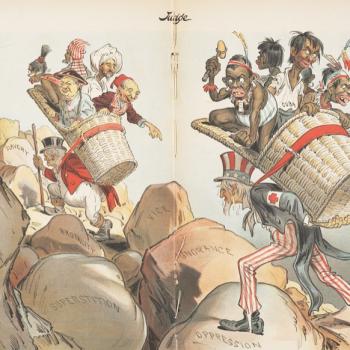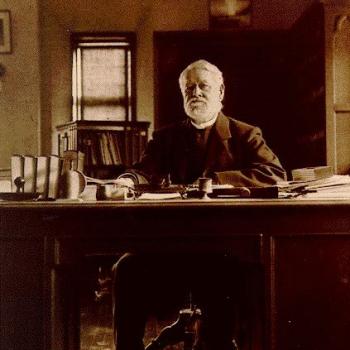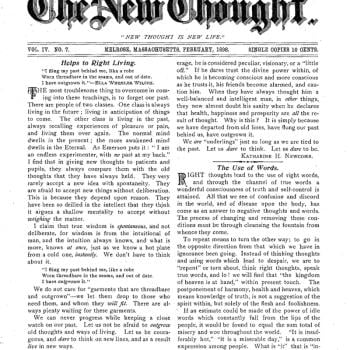Last time, I discussed the dilemma of how we commemorate early leaders who bought or held slaves, specifically thinking of American Puritans like Jonathan Edwards or John Myles. I suggested that we need to pay very close attention to historical context in judging such acts. Understanding all assuredly does not pardon all, but it does raise some significant caveats.
Primarily, we need to recall that prior to quite modern times – the mid-eighteenth century, say, mainly after 1770 – campaigns against slavery as an institution are sporadic, scarce, and deeply ambiguous. In the Roman world, for instance, anyone who could afford to own slaves did so without qualms. That included the holders of vast landed estates, but also quite small time people whom we might think of as lower middle class. The overwhelming majority of people who left writings that survive into later times were of the class that owned slaves, even if we can’t point to individuals and definitely assert that they did so. Among other people, that statement includes most of the prominent Christians that we know before (say) the sixth century, and most of the Fathers. If we can’t clearly show that a particular individual in that era did not own slaves, then we should assume that they did.
If that statement sounds controversial, let me elaborate. Delving into Patristic literature produces quite a few sentiments that appear hostile to slave holding or the slave trade. But before reading these through the lens of Victorian-era abolitionism, we need to consider other possible interpretations. Generally, such ancient comments demand a humane and decent approach to slavery, rather than its abolition, or the construction of a slave-free society. It is very easy indeed to find such quotations from particular thinkers who supported slavery in all its essentials. I like the Wikipedia comment on the great St. John Chrysostom, around 400 AD, who “opposed unfair and unjust forms of slavery by giving … instructions to those who owned slaves.” By implication, he had no problem with “fair and just forms” of the same practice. And what exactly would those be?
Reading such Patristic comments closely, we often find that what the ancients are actually presenting is one of the following approaches:
* Slave owners should treat their slaves with humanity and compassion.
* Slave owners should avoid brutality or sexual exploitation.
* Owners should consider freeing or manumitting their slaves on easy or generous terms (which did not prevent replacing them with new arrivals).
* Christians should be guided by the Old Testament laws of slavery, which prescribed strict time limits on the practice.
* Christians should support the purchase and release of slaves in special circumstances, especially of Christian captives taken in war.
* Slave raiding was to be condemned, especially between Christian communities.
* Slavery existed because of the Fall and sinfulness, and was not part of the original divine plan (which is not to say that particular slave owners were committing sins by virtue of their status, any more than if they held other kinds of property)
Other possible examples can be offered, but these should suffice to show the importance of reading in context. Early Christians advocated plenty of things that would, if implemented, have vastly improved the conditions of slaves. Very, very, few advocated the ending of slavery, or even conceived of such a world, except in an apocalyptic or messianic context. Nor do we have much idea of how widely, if at all, such specific recommendations were out into effect.
Now, we can point out here that slavery in the ancient Mediterranean world was a very different animal from what existed in the Early Modern Atlantic, and that boundaries between slave and free were much more permeable. Ancient slaves were likely to gain freedom in various ways, and had a great deal of latitude to operate on a fairly independent level. But slaves they were. Should we avoid commemorating or celebrating any ancient thinkers or writers who lived in slave societies, and who presumably participated in that slavery system? Which as I say, was basically all advanced societies in that era.
The same comment about the pervasive impact of slavery would also apply to (for instance) all Islamic societies up to very modern times, and many advanced African communities. The Prophet Muhammad often praised the virtue of liberating slaves, which he cited as an act that gave special pleasure to Allah. We should not read that as a warrant for abolitionism. If we are ever attempted to sidestep Euro-American heroes and heroines and replace them with figures from other civilizations, we would be hard put to avoid slave owners, or people who never thought to confront the slavery they saw all around them.
Do all historical slave owners need to be condemned to oblivion and obloquy? Does the fact of that slave owning need to be acknowledged in all references to them and their work? Was it a defining part of their historical reality?
As an example, I think of the recent story from Worcester Art Museum, where captions describing American paintings have gone beyond a simple recording of title and artist, with dates of birth and death. Instead, any connections to the slave system must be placed front and center. Thus, a John Singleton Copley painting of Lucretia Chandler Murray
informed me that Lucretia’s father owned two enslaved persons whom he later left in his will to family members. One was named Sylvia and the other Worcester. While both Lucretia’s father and her husband had the financial means to pay for Copley’s talents, their enslaved persons did not.
Another painting by John Wollaston of Ann Gibbes (1767), “notes that her father owned a plantation in South Carolina that had 68 enslaved persons.” In using such tags, Worcester is of course trying to make multiple points, not least that slavery was not just something that happened far away in the South, but was very widespread in northern and mid-Atlantic colonies, which is entirely true.
Do note that such tags only apply to American paintings. If they were used for Classical and Ancient artworks, then literally every sculpture and mosaic prior to 600 AD or so would have such a label. So would all Islamic, Persian, or Indian artworks through most eras. So if these labels apply to everything, why bother to include them for any?
London’s British Library currently has a magnificent and much lauded exhibition of Anglo-Saxon art and manuscripts, from a country that was one of the treasure houses of medieval Europe, and a key center of Christian learning. Not mentioned on any comparable caption is the fact that the same Anglo-Saxon England was very much a slave society, where perhaps 10 percent of the population were in bondage, and where slave raiding and trading were both key parts of economic life and political action. Should that have been acknowledged? If not, why not? Or is historical slavery only of interest in a North American context? (Please understand, that exhibition does mention Anglo-Saxon slaves in particular contexts, but with nothing like the centrality of the Worcester Art exhibit).
Perhaps art galleries should include large illuminated signs for those exceedingly rare individuals in those earlier eras who can conclusively be shown not to have held slaves, ever, although they had the means to do so, and such arrangements were legally possible given the particular time and place. Very few such signs would be required.













